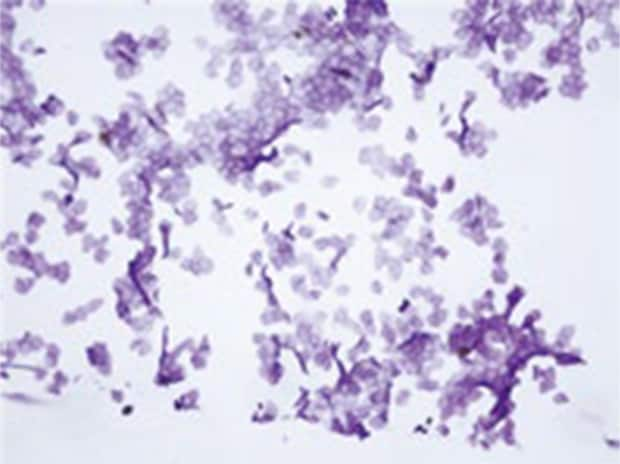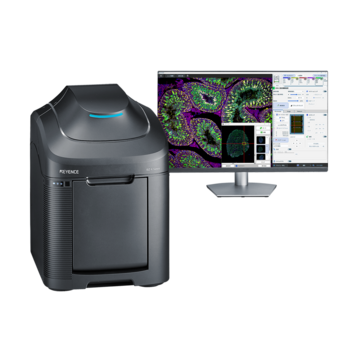Fluorescence Microscopes
Skin structure
Skin is composed of three layers: the epidermis, the dermis, and the hypodermis. The epidermis, which is the outermost of these three layers, is further subdivided into four layers: the cornified layer (stratum corneum), the granular layer (stratum granulosum), the spinous layer (stratum spinosum), and the basal layer (stratum basale). The cornified layer cells, lipid lamellar structure that exists between the cells, and the tight junctions within the granular layer all help the skin to serve as a barrier. The lamellar structure refers to the reciprocal overlapping of water and oil by way of ceramides, which possess both hydrophobic and hydrophilic molecules. Since the lamellar structure suppresses the evaporation of moisture from the skin, any disturbances can result in increased moisture loss and drying. This will lead to a decrease in the skin's barrier function, which is believed to be a cause of skin problems. Additionally, the nuclei and organelles of the cornified layer cells will be lost, causing the cells to be covered with a protein called CE in lieu of the cell membrane. The lamellar structure is built with CE as its base, so it is important for the CE to sufficiently mature in order for the barrier function to work properly.

The cycle used to rejuvenate the skin is called turnover and has great importance in skin condition evaluation. Skin cells are developed in the basal layer, which is the bottommost layer in the epidermis, and are gradually pushed upward while repeatedly undergoing cell division. Eventually, the cells that lose their nuclei appear on the surface of the epidermis as cornified layer cells (keratinocytes). Finally, dead skin cells peel off. In normal functioning skin, turnover is repeated with a fixed cycle. However, factors such as ultraviolet light and stress can lead to irregular turnover cycles. If the turnover cycle is disturbed, then the skin's barrier function will decrease, leading to skin irritation, blemishes, and other skin problems.
Get detailed information on our products by downloading our catalog.
View Catalog

Tape stripping test
Generally, to perform a skin condition evaluation, the tape stripping test is carried out. In the tape stripping test, skin is peeled off with a piece of adhesive tape, and then dyed cornified layer cells are evaluated.
It is believed that the cornified layer cell area is an indicator of the turnover speed. If strong external stimulus is applied to the skin, the turnover speed will increase, thereby making the cornified layer cell area smaller. On the other hand, in aged cells or in circumstances where the metabolic function has declined, the turnover speed will decrease, thereby making the cornified layer cell area larger.
Furthermore, the peeling of multiple layers is often seen with dry skin. This indicates the peeling of multiple layers of cornified layer cells, which should peel off one layer at a time.
The maturity of cornified layer cells is evaluated with the ratio of the SH group to the SS group. As these cells mature, the SH group is converted to the SS group. As such, cells having a high SH/SS ratio appearing on the surface layer indicates that the maturity of the cornified layer is low. There is another method for determining the maturity of the cornified layer cells: evaluating the amount of CE. Examining these conditions creates a more thorough picture for quantitatively understanding the skin condition.
We’re here to provide you with more details.
Reach out today!

Example of a tape stripping evaluation
In the following example, KEYENCE’s All-in-One Fluorescence Microscope BZ-X is used to observe cornified layer cells peeled off from skin via tape stripping. The skin condition can be evaluated by measuring the cornified layer cell area and the ratio of multiple peeled off layers. These measurements can also be used to quantify how much turnover is improved by cosmetics. However, these measurements were time-consuming to perform using conventional methods, which limited data reliability by reducing the number of experiments that can be done.
With the BZ Series, the Cell Count function can be used to easily measure the average area of cornified layer cells and the ratio of multiple peeled off layers.


Average area

Stratification comparison
Furthermore, the Macro Cell Count function can be used to obtain reliable results by measuring a large number of samples under the same conditions.

A:Batch measurement B:Area
Macro quantification function
Using the All-in-One Fluorescence Microscope BZ-X
- Individual adjacent corneocytes can be extracted and counted using Hybrid Cell Count.
- The Macro Cell Count can be used to apply the measurement conditions used to run the Hybrid Cell Count to multiple images for batch measurement.


